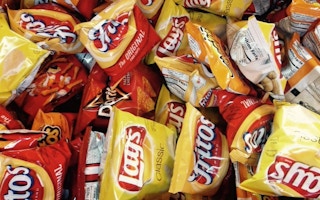It may seem counterintuitive, but a new version of the lightweight plastic sheet used to wrap food and groceries could not increase but reduce waste generated today. Sure, the plastic is not perfectly biodegradable yet, but an improved plastic cover developed by Singapore scientists can prevent consumers from throwing away perfectly edible food.
To continue reading, subscribe to Eco‑Business.
There's something for everyone. We offer a range of subscription plans.
- Access our stories and receive our Insights Weekly newsletter with the free EB Member plan.
- Unlock unlimited access to our content and archive with EB Circle.
- Publish your content with EB Premium.
The technology synthesises plastics that can extend food’s shelf life, absorb gases that accelerate decomposition and even indicate the quality of the food within.
Heading the team working to find industrial uses for plastic polymers is Dr Li Xu from the Institute of Materials Research and Engineering (IMRE) within Singapore’s national agency for research and development, A*Star.
His team has developed Advanced Polymer Composites Food Packaging, which can be tweaked to offer three functions according to what the client company desires.

Product samples of A*Star’s innovative food packaging. Image: A*Star
Firstly, plastics can be engineered to be “high barrier” and keep out oxygen, moisture or UV rays to slow the speed of ripening or decomposition. Called inert packaging, the new high-barrier plastic is more protective. The rate of oxygen passing through the packaging is less than one-quarter of commercial-standard metallised plastic film, the kind of plastic potato chips are sold in, for instance.
The second variation is called “active” packaging, which is plastic containing elements that absorb oxygen, moisture or ethylene, an organic compound produced by fruits and vegetables that cause them to ripen.
Finally, “intelligent” food packaging can indicate if the food is still edible or if the packaging integrity has been damaged i.e there has been a tear, or if the storage environment has been compromised. For instance, the colour of the plastic could change to indicate that the food should no longer be consumed based on when the food actually spoils rather than the expiry date.
Explaining the last, Li said: “It’s like when you take ice cream out of the refrigerator for a while and put it back in. Nobody may know, but the taste and texture of the ice cream is changed.”
International market demand for flexible plastic packaging market will be worth US$351 billion by 2018, say market reports. Asia-Pacific leads the pack in packaging consumption and is responsible for 44 per cent of global use.
According to the Food and Agriculture Organization of the United Nations, almost one-third or 1.3 billion tonnes of food produced in the world gets lost or wasted. Singapore generated 785,500 tonnes of food waste in 2015, said the National Environment Agency.
IMRE started to bring its polymer technology to the market in 2012 through the Industrial Coating and Packaging (ICAP) Consortium it had set up with key partners throughout the vertical supply chain, including small-medium enterprises based in Singapore and large multi-national companies. The consortium also helps local SMEs to reach out to MNCs for partnerships.
It is currently working with two separate groups to roll out high barrier and active packaging. Li predicted that high barrier packaging could come into mainstream use as soon as next year, though intelligent food packaging may only be ready in the next five years.
Since the start of the consortium, IMRE has seen interest from companies from Singapore, Thailand, Malaysia, and Japan in adopting its technologies.
“
Maybe we cannot affect climate change (per se), but for us if we can focus on food packaging to improve shelf life and retain freshness, we can reduce wastage from good food being thrown out because of the expiry date.
Dr Li Xu, senior scientist III, polymeric materials at the Institute of Materials Research and Engineering, A*Star
But Li conceded that his team’s Advanced Polymer Composites Food Packaging is not yet the be-all, end-all to food packaging solutions as the plastic is not biodegradable - but they are working on it.
“Maybe we cannot affect climate change, but for us if we can focus on food packaging to improve shelf life and retain freshness, we can reduce wastage from good food being thrown out because of the expiry date,” he said, commenting that people buy and dispose of food base on its appearance, but with the right packaging the colour can be kept for a long time.
“This is our social responsibility,” Li added.










